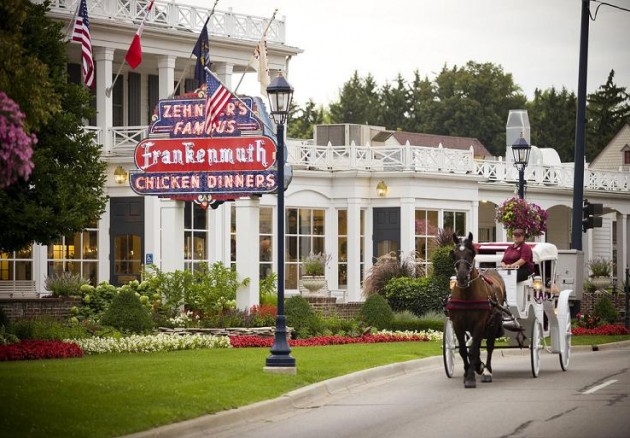
Call William Directly at 248.980.2455
How Did Michigan Cities Get Their Names? Parts 1, 2 and 3
Each city in Michigan has a unique history and tradition. This includes everything from when the city was created to how it was named. With that in mind, Pure Michigan created a new feature on their Pure Michigan Connect blog where they tell the story of how several Michigan cities earned their names. Check out the the 3 part series below:
Detroit:
Let’s start with Detroit, the city with the most Michiganders and one of the oldest cities in the Midwest. The city is named after the Detroit River, which links Lake Huron and Lake Eric. The word “detroit” is French for “strait,” and the French called the river “le détroit du Lac Érié,” meaning “the strait of Lake Erie.” On July 24, 1701, a French explorer and nobleman by the name of Antoine de la Mothe, sieur de Cadillac founded Detroit. Check out the Detroit Fall Beer Festival on October 22 at Eastern Market, which will feature more than 40 Michigan craft breweries offering more than 200 different beers for sampling throughout the day.
Mackinac Island:
Like many historic places in the Great Lakes region, Mackinac Island’s name derives from a Native American language. It’s been said that Native Americans thought the shape of the island resembled a turtle, so they named it “Mitchimakinak” meaning “big turtle.” Then, the French used their own version of the original pronunciation and named it Michilimackinac. However, the English shortened it to the present name: “Mackinac.” You can check out live streaming video of Main Street on Mackinac Island here.
Traverse City:
Traverse City’s name is almost self-explanatory – it is named after the Grand Traverse Bay. Indian hunters and French traders were the first people to spend time here, and it was they who gave the region its name – La Grand Traverse, because of the “long crossing” they had to make by canoe across the mouth of the bay. But even the native Ottawa and Chippewa people didn’t settle here permanently until the early 18th century. Check out the Traverse City page on michigan.org for a listing of more than 150 boutiques and restaurants.
Ludington:
Ludington wasn’t always knows as Ludington, but was originally named Pere Marquette Village, which was named after French missionary and explorer Father Jacques Marquette. After it was settled in 1847, a number of lumbering camps sprung up in the area, and a lumber baron named James Ludington built and settled into what are now impressive historic homes. Residents later renamed the city after him. It’s a place where simple, timeless joys are Pure Michigan.
Grand Rapids:
Before it was named Grand Rapids, the area was settled by Ottawa Indians near the Grand River Valley. One French trader named Louis Campau established a trading post in the area in 1826 and in 1831, he bought 72 acres of land from the federal government for $90 and named his land “Grand Rapids.” This land is now the entire downtown business district of the city. It’s a place created by and for artists of all types, and you can learn more on the Grand Rapids page on Michigan.org.
Lansing:
How the name of Michigan’s capital city came to be is a fun story. In the 1830s, two brothers from New York tried to scam their fellow statesman by going to Lansing, New York, and trying to sell plots of land in an area of Michigan that was underwater most of the year. When men who bought plots of land realized they had been scammed, they settled in the area that is now metropolitan Lansing and renamed the area “Lansing Township” as an homage to their home village in New York. In 1847, the state constitution required that the capital of Michigan be moved out of Detroit. Lansing Township was chosen out of frustration with the process. In 1848, the area was eventually given the name of Lansing. From November 9 – 17, check out the Lansing Film Festival, which will feature foreign films, documentaries and student productions from around the world.
Ann Arbor:
There are a couple theories about the origin of Ann Arbor, but the most agreed-upon theory revolves around two men named John Allen and Elisha Ramsey, two pioneers who were part of a group of settlers who set up a community by the Huron River in 1824. Both Rumsey and Allen’s wives were named Ann, and the word “arbor” means “a leafy, shady recess formed by tree branches, shrubs, etc.,” which perfectly describes the landscape of the area in 1824.
Petoskey:
Surrounded in mystery and legend, Petoskey is said to be named after the son of a French fur trader and Ottawa princess. He was named Petosegay. The translation of the name is “rising sun,” “rays of dawn,” or “sunbeams of promise” due to the bright light that shone on his face near the Kalamazoo river when he was born. He was a successful merchant and trader, who also married an Ottawa princess. It’s said a small settlement was started on his land just a north of Bear Creek and was named Petoskey (an English translation) after him. Petoskey is known for its bike trails, including Little Traverse Wheelway, a 26-mile stretch that follows the shoreline from Charlevoix north to Harbor Springs.
Bad Axe:
While surveying Huron County in 1861, Rudolph Papst and George Willis Pack made camp and found a badly damaged axe at the site. The camp became known as Bad Axe Camp after a sign Papst placed at the camp and near a trail. When he returned from the Civil War in 1870, he founded a small city in the place of the camp. It was called Bad Axe.
Sault Sainte Marie:
The origin of the name of the oldest city in Michigan goes back to the 1600s, when French missionaries and fur traders went into the area, calling it Sault du Gastogne. In 1668, Fr. Jacques Marquette, who you may remember from the story of Ludington’s history in part one, renamed the settlement Sault Ste. Marie, in honor of the Virgin Mary—the first “city” in the Great Lakes region. Fun fact: Native Americans gathered here more than 2,000 years ago for the wealth of fish and fur and called the area “Bahweting,” or “The Gathering Place.” In February, check out the 44th Annual International I-500 Snowmobile Race, also nicknamed “NASCAR on Ice.”
Kalamazoo:
Kalamazoo, the largest city in Southwest Michigan, was originally known as “Bronson,” after founder Titus Bronson. In the 1830s, the name was changed to the Native American word “Kalamazoo,” but there are several theories to its exact origin. Some say it means “the mirage of reflecting river,” while others say it means bubbling or boiling water. Another legend is that the image of “boiling water” referred to fog on the river as seen from the hills above the current downtown.
Grosse Pointe:
Grosse Pointe, sometimes called “the Pointes,” refers to a comprised area of five individual communities outside of Metro Detroit. The name “Grosse Pointe” derives from the size of the area and its projection into Lake St. Clair.
Frankenmuth:
Frankenmuth, often referred to as “Michigan’s Little Bavaria,” was settled and named in 1845 by immigrants from Franconia (now part of Bavaria) in Germany. The German word “franken” represents the Province of Franconia in the Kingdom of Bavaria, and the German word “mut” means courage, which makes the city name of Frankenmuth stand for “courage of the Franconians.” Families flock to Frankenmuth to enjoy Christmas celebrations yearlong, in addition to a number of other activities.
Albion:
The city of Albion was almost named “Peabodyville,” after Tenney Peabody, the first European-American settler to arrive in the area in 1833. The area remained nameless until 1835, when a man named Jesse Crowell formed a residence and land development company called the Albion Company. Peabody’s wife was then asked to name the settlement and while she considered using her husband’s name, she ultimately selected “Albion.” The name was appropriate, since “Albion” is an old and poetic name for England, and many of the early settlers were of English decent.
Muskegon:
Like many other cities in Michigan, Native American tribes inhabited what’s known as Muskegon during historic times. The word “Muskegon” is derived the Ottawa Native American term “Masquigon,” meaning “marshy river or swamp.” The “Masquigon” river was identifed on French maps dating back to the late 17th century, suggesting that French explorers had reached Michigan’s western coast by that time. Today, people enjoy the water and sand dunes in Muskegon every summer.






